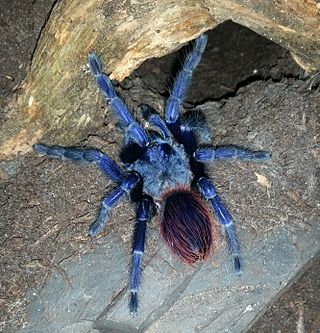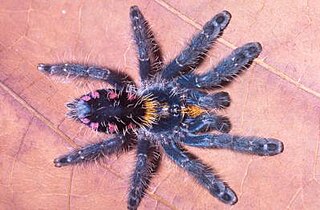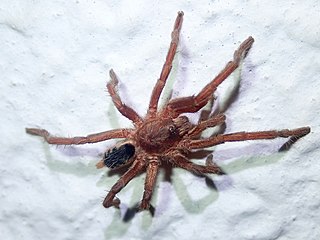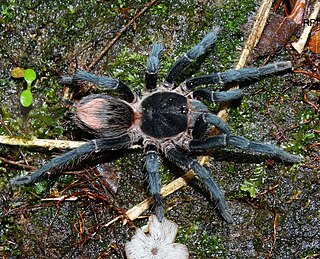
Dolichothele is a genus of spiders in the family Theraphosidae found in Brazil and Bolivia. It was first described in 1923 by Mello-Leitão.

Theraphosa is a genus of South American tarantulas that was first described by Charles Athanase Walckenaer in 1805. The Theraphosa spiders are some of the largest known to science. As of May 2020 it contains three species, found in Guyana, Brazil, Venezuela, and Colombia. They stridulate by rubbing setae on their pedipalps and legs.

Tarantulas comprise a group of large and often hairy spiders of the family Theraphosidae. As of December 2023, 1,100 species have been identified, with 166 genera. The term "tarantula" is usually used to describe members of the family Theraphosidae, although many other members of the same infraorder (Mygalomorphae) are commonly referred to as "tarantulas" or "false tarantulas". Some of the more common species have become popular in the exotic pet trade. Many New World species kept as pets have setae known as urticating hairs that can cause irritation to the skin, and in extreme cases, cause damage to the eyes.

Neischnocolus is a genus of spiders in the family Theraphosidae. It was first described in 1925 by Petrunkevitch. The genus Ami was separately described in 2008, but was later discovered to be a junior synonym of Neischnocolus. Species are native to Central America and northern South America.

Lasiocyano is a genus of tarantulas. As of June 2023, it was a monotypic genus with the sole species Lasiocyano sazimai, synonym Pterinopelma sazimai, known as the Brazilian blue, iridescent blue or Sazima's tarantula. The species was first described by Rogério Bertani, Roberto Hiroaki Nagahama and Caroline Sayuri Fukushima in 2011. In 2012, it became the first Brazilian species to appear on the International Institute for Species Exploration's top 10 new species list. The species name honors Ivan Sazima, a Brazilian zoologist who was the first to collect exemplars of the species. It is now considered an endangered species owing to smuggling and a shrinking habitat.

Cyriopagopus is a genus of southeast Asian tarantulas found from Myanmar to the Philippines. As of March 2017, the genus includes species formerly placed in Haplopelma. It was first described by Eugène Louis Simon in 1887.
Rogério Bertani is a Brazilian arachnologist, active at the Butantan Institute.
The Ischnocolinae are a problematic subfamily of tarantulas. In 1892, Eugène Simon based the group, which he noted was only weakly homogeneous, on the presence of divided tarsal scopulae. This feature was later considered to be plesiomorphic, and both morphological and molecular phylogenetic studies have shown that, as traditionally circumscribed, the subfamily is not monophyletic. A much more narrowly defined Ischnocolinae sensu stricto was proposed in 2014. One of the authors of that proposal subsequently said that no further taxonomic changes should be considered until there had been a more comprehensive sampling of the subfamily. As of January 2021, the status of the Ischnocolinae remains unresolved.

Typhochlaena costae is a species of tarantula in the family Theraphosidae, subfamily Aviculariinae. It is native to Palmas, Tocantins state, Brazil. The species shows an arboreal trapdoor lifestyle.

Typhochlaena seladonia is a species of aviculariine tarantula, and is the type species of the genus Typhochlaena. It is unique as an arboreal spider that constructs trapdoors in the bark of trees.
Neostenotarsus is a genus of theraphosid spider, in the Theraphosinae subfamily. It is native to French Guiana. It is monotypic, the only species being Neostenotarsus scissistylus.

Nhandu is a genus of South American tarantulas that was first described by S. Lucas in 1983. Brazilopelma was synonymized with it in 2001.
Pterinopelma is a genus of Brazilian tarantulas that was first described by Reginald Innes Pocock in 1901. As of June 2023 it contains two species, found in Brazil: P. felipeleitei and P. vitiosum. It was removed from the synonymy of Eupalaestrus in 2011.
Trichopelma is a genus of South American and Caribbean tarantulas first described by Eugène Simon in 1888.

Guyruita is a genus of South American tarantulas that was first described by J. P. L. Guadanucci in 2007.

Homoeomma is a genus of South American tarantulas that was first described by Anton Ausserer in 1871. It is considered a senior synonym of Calopelma, Butantania, and of Cyclothoracoides. These tarantulas are usually quite small and usually burrow a few centimeters under a rock or log.

Vitalius is a genus of South American tarantulas that was first described by S. Lucas, P. I. da Silva Jr. & Rogério Bertani in 1993.

Neoholothele is a genus of tarantula, first described in 2015 by Guadanucci & Weinmann. As of August 2022, it contains 2 species Neoholothele fasciaaurinigra and Neoholothele incei, the latter being the type species. They are named after the prefix "neo" from the Greek word for new, and the genus Holothele.
Yanomamius is a genus of South American tarantulas first erected by Rogério Bertani and M. Q. Almeida in 2021 for two newly discovered species and one previously described species from Brazil. In one of Bertani's prior studies, he investigated a tarantula collected by the Yanomami as a source of food. Based on the limited material available for study- two adult females and one immature spider- the species was placed into Holothele. The next year, it was moved to newly erected genus Guyruita due, in part, to the multi-lobed shape of its spermathecae. When the first male was found and described, the diagnostic characteristics didn't match that of Holothele or Guyruita, so a new genus was erected for Y. waikoshiemi and three other closely related species.
Ischnocolus vanandelae is a tarantula species in the Ischnocolus genus, it is found in Oman, and Iran, it was first described in 2020 by Vivian M. Montemor, Rick C. West, Alireza Zamani. This spider is named after Mrs. Priscilla M. J. van Andel, a Dutch wildlife enthusiast, who first collected this species with her husband Mr. J. H. Hans Raaijmakers.












